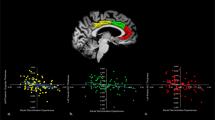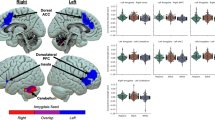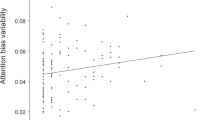Abstract
Prior research has shown that racial discrimination (RD) impacts activation in threat network regions, including the ventromedial prefrontal cortex (vmPFC) and middle occipital cortex during attention to threat-relevant stimuli. However, little is known about the biological mechanisms that may modulate these effects; inflammation may be a pathway linking RD and threat network activation. As such, the current study aimed to explore whether systemic inflammation, measured by C-reactive protein (CRP) levels, may moderate the relationship between RD and activation in the vmPFC and middle occipital cortex during attention to threat. Blood samples for inflammatory marker (CRP) assays were obtained from forty Black American women (mean [SD] age, 39.93 [9.97] years; range, 22–58 years) recruited from an ongoing trauma study; participants also viewed threat-relevant stimuli as part of an attention task during fMRI. We found that CRP moderated the relationship between RD and vmPFC activation during attention to threat, such that participants with relatively higher concentrations of CRP ( ≥ 23.97 mg/L) demonstrated significant positive associations between RD and vmPFC activation [β = 0.18, CI (0.04, 0.32), t = 2.65, p = 0.01]. No significant associations were observed for participants who showed moderate (10.89 mg/L) or low (0.20 mg/L) CRP concentrations. CRP did not moderate the relationship between RD and middle occipital cortex activation. Our data present a mechanism through which RD may influence immune system activation and, in turn, threat network activation. Inflammation may contribute to brain health vulnerabilities in Black Americans via its effects on threat circuits; this merits further investigation in large-scale studies.
This is a preview of subscription content, access via your institution
Access options
Subscribe to this journal
Receive 13 print issues and online access
$259.00 per year
only $19.92 per issue
Buy this article
- Purchase on Springer Link
- Instant access to full article PDF
Prices may be subject to local taxes which are calculated during checkout

Similar content being viewed by others

References
Lee RT, Perez AD, Boykin CM, Mendoza-Denton R. On the prevalence of racial discrimination in the United States. PLOS ONE. 2019;14:e0210698.
Small ML, Pager D. Sociological perspectives on racial discrimination. J Econ Perspect. 2020;34:49–67.
Pachter LM, Bernstein BA, Szalacha LA, García Coll C. Perceived racism and discrimination in children and youths: an exploratory study. Health Soc Work. 2010;35:61–9.
Helms JE, Nicolas G, Green CE. Racism and ethnoviolence as trauma: enhancing professional training. Traumatology. 2012;16:65–74.
Assari S, Mistry R, Caldwell CH. Perceived discrimination and substance use among caribbean black youth; Gender Differences. Brain Sci. 2018;8:131.
Mekawi Y, Carter S, Brown B, Martinez de Andino A, Fani N, Michopoulos V, Powers A. Interpersonal trauma and posttraumatic stress disorder among black women: does racial discrimination matter? J Trauma Dissoc. 2021;22:154–69.
Bird CM, Webb EK, Schramm AT, Torres L, Larson C, deRoon-Cassini TA, et al. Racial discrimination is associated with acute posttraumatic stress symptoms and predicts future posttraumatic stress disorder symptom severity in trauma-exposed black adults in the United States. J Traumatic Stress. 2021;34:995–1004.
Liu Y, Wang Y, Jiang C. Inflammation: The common pathway of stress-related diseases. Front Human Neurosci. 2017;11:316.
Elenkov IJ. Neurohormonal-cytokine interactions: implications for inflammation, common human diseases and well-being. Neurochem Int. 2008;52:40–51.
Hansel A, Hong S, Camara RJA, von Kanel R. Inflammation as a psychophysiological biomarker in chronic psychosocial stress. Neurosci Biobehav Rev. 2010;35:115–21.
Rohleder N. Stimulation of systemic low-grade inflammation by psychosocial stress. Psychosom Med. 2014;76:181–9.
Cuevas AG, Ong AD, Carvalho K, Ho T, Chan S, Allen JD, et al. Discrimination and systemic inflammation: A critical review and synthesis. Brain Behav Immun. 2020;89:465–79.
Freilich CD, Mann FD, Cole SW, Krueger RF. Intersectional vulnerability in the relationship between discrimination and inflammatory gene expression. Brain Behav Immun Health. 2023;27:100580.
Stepanikova I, Bateman LB, Oates GR. Systemic inflammation in midlife: race, socioeconomic status, and perceived discrimination. Am J Preventative Med. 2017;52:S63–S76.
Giurgescu C, Engeland CG, Templin TN, Zenk SN, Koenig MD, Garfield L. Racial discrimination predicts greater systemic inflammation in pregnant African American women. Appl Nurs Res. 2016;32:98–103.
Felger JC, Haroon E, Patel TA, Goldsmith DR, Wommack EC, et al. What does plasma CRP tell us about peripheral and central inflammation in depression? Mol Psych. 2020;25:1301–11.
Eklund CM. Proinflammatory cytokines in CRP baseline regulation. Adv Clin Chem. 2009;48:111–36.
Wolska A, Remaley AT. CRP and high-sensitivity CRP: “What’s in a Name?”. J Appl Lab Med. 2022;7:1255–8.
Slopen N, Koenen KC, Kubzansky LD. Childhood adversity and immune and inflammatory biomarkers associated with cardiovascular risk in youth: a systematic review. Brain Behav Immun. 2012;26:239–50.
Schmeer KK, Yoon A. Socioeconomic status inequalities in low-grade inflammation during childhood. Arch Dis Child. 2016;101:1043–7.
Kuhlman KR, Chiang JJ, Horn S, Bower JE. Developmental psychoneuroendocrine and psychoneuroimmune pathways from childhood adversity to disease. Neurosci Biobehav Rev. 2017;80:166–84.
Alley DE, Seeman TE, Ki Kim J, Karlamangla A, Hu P, Crimmins EM. Socioeconomic status and C-reactive protein levels in the US population: NHANES IV. Brain Behav Immun. 2006;20:498–504.
Neblett J, Bernard DL. The moderating roles of gender and socioeconomic status in the association between racial discrimination and psychological adjustmen. Cogn Behav Pract. 2016;23.
Muscatell KA, Brosso SN, Humphreys KL. Socioeconomic status and inflammation: a meta-analysis. Mol Psych. 2020;25:2189–99.
Muscatell KA, Moieni M, Inagaki TK, Dutcher JM, Jevtic I, Breen EC, Irwin MR, Eisenberger NI. Exposure to an inflammatory challenge enhances neural sensitivity to negative and positive social feedback. Brain Behav Immun. 2016;57:21–29.
Hong S, Nelesen RA, Krohn PL, Mills PJ, Dimsdale JE. The association of social status and blood pressure with markers of vascular inflammation. Psychosom Med. 2006;68:517–23.
Mehta ND, Stevens JS, Li Z, Gillespie CF, Fani N, Michopoulos V, Felger JC. Inflammation, reward circuitry and symptoms of anhedonia and PTSD in trauma-exposed women. Soc Cogn Affect Neurosci. 2020;15:1046–55.
Mehta ND, Stevens JS, Li Z, Fani N, Gillespie CF, Ravi M, Michopoulos V, Felger JC. Inflammation, amygdala-ventromedial prefrontal functional connectivity and symptoms of anxiety and PTSD in African American women recruited from an inner-city hospital: Preliminary results. Brain Behav Immun. 2022;105:122–30.
Eisenberger NI, Moieni M, Inagaki TK, Muscatell KA, Irwin MR. In Sickness and in Health: The Co-Regulation of Inflammation and Social Behavior. Neuropsychopharmacology. 2017;42:242–53.
Yan Q. Stress and systemic inflammation: Yin-Yang dynamics in health and diseases. Methods Mol Biol. 2018;1781:3–20.
Rohleder N. Stress and inflammation–The need to address the gap in the transitionbetween acute and chronic stress effects. Psychoneuroendocrinology. 2019;105:164–71.
Powell ND, Sloan EK, Bailey MT, Arevalo JM, Miller GE, Chen E, et al. Social stress up-regulates inflammatory gene expression in the leukocyte transcriptome via beta-adrenergic induction of myelopoiesis. Proc Natl Acad Sci USA. 2013;110:16574–9.
Boen C. Death by a thousand cuts: stress exposure and black–white disparities in physiological functioning in late life. J Gerontol. 2019;75:1937–50.
Ong AD, Williams DR, Nwizu U, Gruenewald TL. Everyday unfair treatment and multisystem biological dysregulation in African American adults. Cult Divers Ethn Minor Psychol. 2017;23:27–35.
Kershaw KN, Lewis TT, Diez Roux AV, Jenny NS, Liu K, Penedo FJ, Carnethon MR. Self-reported experiences of discrimination and inflammation among men and women: The multi-ethnic study of atherosclerosis. Observ Study 2016;4:343–50.
Friedman EM, Ryff CD. Chronic discrimination predicts higher circulating levels of E-selectin in a national sample: The MIDUS study. Brain, Behav Immun. 2009;23:684–92.
Waller RJ. Application of the kindling hypothesis to the long-term effects of racism. Social Work Mental Health. 2008;1:81–9.
Utsey SO, Belvet B, Gladney LL. Development and validation of the prolonged activation and anticipatory racerelated stress scale. J Black Psychol. 2012;39:532–59.
Felger JC. Imaging the role of inflammation in mood and anxiety-related disorders. Curr Neuropharmacol. 2018;16:533–58.
Eisenberger NI, Lieberman MD. Why rejection hurts: a common neural alarm system for physical and social pain. Trends Cogn Sci. 2004;8:294–300.
Inagaki TK, Muscatell KA, Irwin MR, Cole SW, Eisenberger NI. Inflammation selectively enhances amygdala activity to socially threatening images. Neuroimage. 2012;59:3222–6.
Kullmann JS, Grigoleit JS, Lichte P, Kobbe P, Rosenberger C, Banner C, Wolf OT, Engler H, Oberbeck R, Elsenbruch S, Bingel U, Forsting M, Gizewski ER, Schedlowski M. Neural response to emotional stimuli during experimental human endotoxemia. Hum Brain Mapp. 2013;34:2217–27.
Mehta ND, Haroon E, Xu X, Woolwine BJ, Li Z, Felger JC. Inflammation negatively correlates with amygdala-ventromedial prefrontal functional connectivity in association with anxiety in patients with depression: Preliminary results. Brain Behav Immun. 2018;73:725–30.
Yin L, Xu X, Chen G, Mehta ND, Haroon E, Miller AH, Luo Y, Li Z, Felger JC. Inflammation and decreased functional connectivity in a widely-distributed network in depression: Centralized effects in the ventral medial prefrontal cortex. Brain Behav Immun. 2019;80:657–66.
Williams DR, Lawrence JA, Davis BA. Racism and health: evidence and needed research. Annu Rev Public Health. 2019;40:105–25.
Masten CL, Telzer EH, Eisenberger NI. An FMRI investigation of attributing negative social treatment to racial discrimination. J Cogn Neurosci. 2011;23:1042–51.
Lucas T, Wegner R, Pierce J, Lumley MA, Laurent HK, Granger DA. Perceived discrimination, racial identity, and multisystem stress response to social evaluative threat among african american men and women. Psychosom Med. 2017;79:293–305.
Clark US, Miller ER, Hedge RR. Experiences of discrimination are associated greater resting amygdala activity and functional connectivity. Biol Psych: Cogn Neurosci Neuroimaging. 2018;3:367–78.
Webb EK, Bird CM, deRoon-Cassini TA, Weis CN, Huggins AA, Fitzgerald JM, Miskovich T, Bennett K, Krukowski J, Torres L, Larson CL. Racial discrimination and resting-state functional connectivity of salience network nodes in trauma-exposed black adults in the United States. JAMA Netw Open. 2022;5:e2144759.
Han SD, Lamar M, Fleischman D, Kim N, Bennett DA, Lewis TT, Arfanakis K, Barnes LL. Self-reported experiences of discrimination in older black adults are associated with insula functional connectivity. Brain Imaging Behav. 2021;15:1718–27.
Fani N, Carter SE, Harnett NG, Ressler KJ, Bradley B. Association of racial discrimination with neural response to threat in black women in the US exposed to Trauma. JAMA Psychiatry. 2021;78:1005–12.
Juster RP, McEwen BS, Lupien SJ. Allostatic load biomarkers of chronic stress and impact on health and cognition. Neurosci Biobehav Rev. 2010;35:2–16.
McEwen BS, Gianaros PJ. Stress- and allostasis-induced brain plasticity. Annu Rev Med. 2011;62:431–45.
Krieger N, Smith K, Naishadham D, Hartman C, Barbeau EM. Experiences of discrimination: validity and reliability of a self-report measure for population health research on racism and health. Soc Sci Med. 2005;61:1576–96.
Sprang G. The traumatic experiences inventory (TEI): A test of psychometric properties. J Psychopathol Behav Assessm. 1997;19:257–71.
Falsetti SA, Dansky BS, Falsetti SA, Saladin ME, Brady KT, et al. The modified PTSD Symptom Scale: A brief self-report measure of posttraumatic stress disorder. Behavior Therapist. 1993;16:161–2.
Felger J, Li Z, Haroon E, Woolwine BJ, Jung MY, Hu X, et al. Inflammation is associated with decreased functional connectivity within corticostriatal reward circuitry in depression. Mol Psych. 2016;21:1358–65.
Bekhbat, M, Li Z, Mehta ND, Treadway MT, Lucido MJ, Woolwine BJ, et al. Symptoms of anhedonia as therapeutic targets in depression with high inflammation: evidence from a dopamine challenge study. Mol Psych. 2022;27:4113–21.
Raschle NM, Fehlbaum LV, Menks WM, Euler F, Sterzer P, Stadler C. Investigating the neural correlates of emotion-cognition interaction using an affective stroop task. Front Psychol. 2017;8:1489.
Fani N, King TZ, Clendinen C, Hardy RA, Surapaneni S, Blair JR, White SF, Powers A, Ely TD, Jovanovic T, Ressler KJ, Bradley B. Attentional control abnormalities in posttraumatic stress disorder: Functional, behavioral, and structural correlates. J Affect Disord. 2019;253:343–51.
Hayes AF. PROCESS: A versatile computational tool for observed variable mediation, moderation, and conditional process modeling. University of Kansas, 2012.
Hayes AF, Montoya AK, Rockwood NJ. The analysis of mechanisms and their contingencies: PROCESS versus structural equation modeling. J Austr Mark. 2017;25:76–81.
Abu-Bader S, Jones TV. Statistical mediation analysis using the sobel test and hayes SPSS process macro. Int J Quant Qualit Res Meth. 2021;9:42–61.
Coutts JJ, Hayes AF. Questions of value, questions of magnitude: An exploration and application of methods for comparing indirect effects in multiple mediator models. Behav Res Meth. 2022;54:1–14.
Gillespie CF, Bradley B, Mercer K, Smith AK, Conneely K, Gapen M, Weiss T, Schwartz AC, Cubells JF, Ressler KJ. Trauma exposure and stress-related disorders in inner city primary care patients. Gen Hospital Psych. 2009;31:505–14.
Ravi M, Mekawi Y, Blevins EJ, Michopoulos V, Stevens J, Carter S, et al. Intersections of oppression: Examining the interactive effect of racial discrimination and neighborhood poverty on PTSD symptoms in Black women. J Psychopath Clin Sci. 2023;132:567–76.
Schwartz AC, Bradley RL, Sexton M, Sherry A, Ressler KJ. Posttraumatic stress disorder among African Americans in an inner city mental health clinic. Psychiatr Serv. 2005;56:212–5.
Steuwe C, Daniels JK, Frewen PA, Densmore M, Theberge J, Lanius RA. Effect of direct eye contact in women with PTSD related to interpersonal trauma: Psychophysiological interaction analysis of connectivity of an innate alarm system. Psychiatry Res. 2015;232:162–7.
Lanius RA, Rabellino D, Boyd JE, Harricharan S, Frewen PA, McKinnon MC. The innate alarm system in PTSD: conscious and subconscious processing of threat. Curr Opin Psychol. 2017;14:109–15.
Cunningham TJ, Seeman TE, Kawachi I, Gortmaker SL, Jacobs DR, Kiefe CI, Berkman LF. Racial/ethnic and gender differences in the association between self-reported experiences of racial/ethnic discrimination and inflammation in the CARDIA cohort of 4 US communities. Soc Sci Med. 2012;75:922–31.
Zahodne LB, Kraal AZ, Zaheed A, Farris P, Sol K. Longitudinal effects of race, ethnicity, and psychosocial disadvantage on systemic inflammation. SSM Popul Health. 2019;7:100391.
Lewis TT, Aiello AE, Leurgans S, Kelly J, Barnes LL. Self-reported experiences of everyday discrimination are associated with elevated C-reactive protein levels in older African-American adults. Brain Behav Immun. 2010;24:438–43.
Cobb RJ, Parker LJ, Thorpe JR. Self-reported instances of major discrimination, race/ethnicity, and inflammation among older adults: evidence from the health and retirement study. J Gerontol. 2020;75:291–6.
Lawrence JA, Kawachi I, White K, Bassett MT, Priest N, Masunga JG, Cory HJ, Mita C, Williams DR. A systematic review and meta-analysis of the Everyday Discrimination Scale and biomarker outcomes. Psychoneuroendocrinology. 2022;142:105772.
Petro NM, Gruss LF, Yin S, Huang H, Miskovic V, Ding M, Keil A. Multimodal imaging evidence for a frontoparietal modulation of visual cortex during the selective processing of conditioned threat. J Cogn Neurosci. 2017;29:953–67.
Leschak CJ, Dutcher JM, Haltom K, Breen EC, Bower JE, Eisenberger NI. Associations between amygdala reactivity to social threat, perceived stress and C-reactive protein in breast cancer survivors. Soc Cogn Affect Neurosci. 2020;15:1056–63.
Swartz JR, Prather AA, Hariri AR. Threat-related amygdala activity is associated with peripheral CRP concentrations in men but not women. Psychoneuroendocrinology. 2017;78:93–96.
Budhwani H, Hearld KR, Chavez-Yenter D. Depression in racial and ethnic minorities: the impact of nativity and discrimination. J Racial Ethn Health Disparities. 2015;2:34–42.
Kirkinis K, Pieterse AL, Martin C, Agiliga A, Brownell A. Racism, racial discrimination, and trauma: a systematic review of the social science literature. Ethn Health. 2021;26:392–412.
Kogan CS, Noorishad PG, Ndengeyingoma A, Guerrier M, Cénat JM. Prevalence and correlates of anxiety symptoms among Black people in Canada: A significant role for everyday racial discrimination and racial microaggressions. J Affect Disord. 2022;308:545–53.
Thomas AJ, Witherspoon KM, Speight SL. Gendered racism, psychological distress, and coping styles of African American women. Cult Div Ethn Minority Psychol. 2008;14:307–14.
Van Gundy KT, Howerton-Orcutt A, Mills ML. Race, coping style, and substance use disorder among non-hispanic african american and white young adults in South Florida. Subst Use Misuse. 2015;50:1459–69.
Gerrard M, Stock ML, Roberts ME, Gibbons FX, O'Hara RE, Weng CY, Wills TA. Coping with racial discrimination: the role of substance use. Psychol Addict Behav. 2012;26:550–60.
Sinha R, Lacadie CM, Constable RT, Seo D. Dynamic neural activity during stress signals resilient coping. Proc Natl Acad Sci USA. 2016;113:8837–42.
Hallion LS, Steinman SA, Tolin DF, Diefenbach GJ. Psychometric properties of the difficulties in emotion regulation scale (DERS) and its short forms in adults with emotional disorders. Front Psychol. 2018;9:539.
Acknowledgements
We thank the members of the Grady Trauma Project and the Fani Affective Neuroscience Laboratory for their assistance with data collection. We thank the participants of the Grady Trauma Project for their time and involvement in this study.
Funding
This work was primarily supported by National Institute of Mental Health (MH101380 to NF) and National Center for Complementary and Integrative Health (AT011267 to NF). Support was also received from the Emory Medical Care Foundation, Emory University Research Council, American Psychological Association, Society for Clinical Neuropsychology, and the National Cancer Institute (CA220254-02S1).
Author information
Authors and Affiliations
Contributions
Aziz Elbasheir had full access to all of the data in the study and takes responsibility for the integrity of the data and the accuracy of the data analysis. Concept and design: Elbasheir and Fani. Acquisition, analysis, or interpretation of data: Elbasheir, Fani, Carter, Harnett, Felger and Michopoulos. Drafting of the manuscript: Elbasheir and Fani. Final approval and critical revision of the manuscript for important intellectual content: All authors. Statistical analysis: Elbasheir and Fani. Obtained funding: Fani. Administrative, technical, or material support: Fani, Carter, and Felger. Supervision: Fani.
Corresponding author
Ethics declarations
Competing interests
The authors declare no competing interests.
Additional information
Publisher’s note Springer Nature remains neutral with regard to jurisdictional claims in published maps and institutional affiliations.
Supplementary information
Rights and permissions
Springer Nature or its licensor (e.g. a society or other partner) holds exclusive rights to this article under a publishing agreement with the author(s) or other rightsholder(s); author self-archiving of the accepted manuscript version of this article is solely governed by the terms of such publishing agreement and applicable law.
About this article
Cite this article
Elbasheir, A., Felger, J.C., Michopoulos, V. et al. C-reactive protein moderates associations between racial discrimination and ventromedial prefrontal cortex activation during attention to threat in Black American women. Neuropsychopharmacol. 49, 593–599 (2024). https://doi.org/10.1038/s41386-023-01737-7
Received:
Revised:
Accepted:
Published:
Issue Date:
DOI: https://doi.org/10.1038/s41386-023-01737-7


